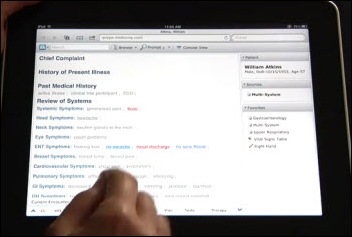News 6/3/11
Top News
![]() Primary care providers treating hepatitis C patients via videoconferencing achieved results identical to those of specialists at a university medical center, according to a NEJM-published study. The program was Project ECHO at the University of New Mexico Health Sciences Center. I interviewed Sanjeev Arora MD, the project’s director, in October 2009. I was impressed.
Primary care providers treating hepatitis C patients via videoconferencing achieved results identical to those of specialists at a university medical center, according to a NEJM-published study. The program was Project ECHO at the University of New Mexico Health Sciences Center. I interviewed Sanjeev Arora MD, the project’s director, in October 2009. I was impressed.
Reader Comments
![]() From DrLover: “Re: DrFirst. Looks like DrFirst is being inundated with requests for people to enroll in eRx before the submission deadline of the end of June. What normally took them three days is up over a week. Thirty days left for providers to write 10 Medicare scripts to prevent 1% penalty, 25 scripts to get 1% bonus.”
From DrLover: “Re: DrFirst. Looks like DrFirst is being inundated with requests for people to enroll in eRx before the submission deadline of the end of June. What normally took them three days is up over a week. Thirty days left for providers to write 10 Medicare scripts to prevent 1% penalty, 25 scripts to get 1% bonus.”
![]() From Kramer: “Re: AHIMA. Just about everyone at the top has left. What’s going on?” I haven’t heard much, although one source says there were internal conflicts after CEO Linda Kloss stepped down a year ago. Former CEO Rose Dunn has been brought back in some capacity (note: I erroneously originally assumed it was Linda Kloss who had returned, but not so). All unverified. I have to admit that the first reaction that both Inga and I had when we got your question was that HIMSS was taking over AHIMA, which isn’t the case as far as I know (but isn’t exactly a far-fetched scenario given the historically acquisitive nature of HIMSS).
From Kramer: “Re: AHIMA. Just about everyone at the top has left. What’s going on?” I haven’t heard much, although one source says there were internal conflicts after CEO Linda Kloss stepped down a year ago. Former CEO Rose Dunn has been brought back in some capacity (note: I erroneously originally assumed it was Linda Kloss who had returned, but not so). All unverified. I have to admit that the first reaction that both Inga and I had when we got your question was that HIMSS was taking over AHIMA, which isn’t the case as far as I know (but isn’t exactly a far-fetched scenario given the historically acquisitive nature of HIMSS).
![]() From N.S. Sherlock: “Re: IBM’s Watson in healthcare. Did you see this? Very interesting.” Above is a video featuring Eliot Siegel MD, professor of diagnostic radiology and nuclear medicine at the University of Maryland School of Medicine. It’s one of two universities working with IBM’s Watson computer to identify potential healthcare applications. They say that Watson can, like a medical student, learn and then apply that knowledge through experience.
From N.S. Sherlock: “Re: IBM’s Watson in healthcare. Did you see this? Very interesting.” Above is a video featuring Eliot Siegel MD, professor of diagnostic radiology and nuclear medicine at the University of Maryland School of Medicine. It’s one of two universities working with IBM’s Watson computer to identify potential healthcare applications. They say that Watson can, like a medical student, learn and then apply that knowledge through experience.
![]() From Pogo: “Re: Healthcare Informatics top 100 vendors list. I bet you have more companies supporting HIStalk as sponsors than they do as advertisers.” Maybe. I eyeballed the list and counted at least 35 of the 100 that sponsor HIStalk, HIStalk Practice, or HIStalk Mobile (some haven’t been announced yet, but are coming soon). Thanks to my sponsors and congratulations to those who made the list. If I ever get the time to reflect, I’m sure I’ll be amazed that so many companies support some hospital guy’s part-time blog – it is truly humbling and there’s no precedent that I know of in Internet-land.
From Pogo: “Re: Healthcare Informatics top 100 vendors list. I bet you have more companies supporting HIStalk as sponsors than they do as advertisers.” Maybe. I eyeballed the list and counted at least 35 of the 100 that sponsor HIStalk, HIStalk Practice, or HIStalk Mobile (some haven’t been announced yet, but are coming soon). Thanks to my sponsors and congratulations to those who made the list. If I ever get the time to reflect, I’m sure I’ll be amazed that so many companies support some hospital guy’s part-time blog – it is truly humbling and there’s no precedent that I know of in Internet-land.
![]() From Maia: “Re: ‘spurred’ customer. Perhaps their previous EMR vendor was Dude Ranch EMR.” An EMR vendor’s press release headline leads off with “After Being Spurred by Previous EMR.” Awkward phrasing for sure and there’s plenty more in the remainder of the release (the verb tense wanders aimlessly throughout). The practice mentioned is an OB/GYN clinic, so maybe they should have worked in an accompanying stirrups pun.
From Maia: “Re: ‘spurred’ customer. Perhaps their previous EMR vendor was Dude Ranch EMR.” An EMR vendor’s press release headline leads off with “After Being Spurred by Previous EMR.” Awkward phrasing for sure and there’s plenty more in the remainder of the release (the verb tense wanders aimlessly throughout). The practice mentioned is an OB/GYN clinic, so maybe they should have worked in an accompanying stirrups pun.
![]() From Klara: “Re: six important letters. Something for you to make fun of.” And I shall: an unfortunate Logicalis press release touts the freshly earned CPHIMS credential of one of its managers as “like a PhD in HIT.” Like a mail-order PhD, maybe — you just have to pass a multiple choice test. No coursework, research, teaching, or real-life competence is required. The odd thing is that their employee, according to her LinkedIn profile, holds a master’s degree that’s worth a lot more than a CPHIMS certificate and they don’t even mention that fact.
From Klara: “Re: six important letters. Something for you to make fun of.” And I shall: an unfortunate Logicalis press release touts the freshly earned CPHIMS credential of one of its managers as “like a PhD in HIT.” Like a mail-order PhD, maybe — you just have to pass a multiple choice test. No coursework, research, teaching, or real-life competence is required. The odd thing is that their employee, according to her LinkedIn profile, holds a master’s degree that’s worth a lot more than a CPHIMS certificate and they don’t even mention that fact.
![]() From Sharky: “Re: Stage 1 MU. IDC Health Insights just put out a list of vendors who have helped customers achieve Stage 1 and Epic isn’t on it. Everyone assumes Epic has customers who have cleared the bar, but why haven’t we seen evidence of this?” I assume because Epic doesn’t do press releases. Note the highlight from the article you mentioned. It’s totally lame, even more so coming from a research company. Attestation started just over a month ago and I doubt many hospitals were ready (compared to small practices, anyway) and especially Epic shops since so many of them signed on in the past year or two. If you run Epic at your place (inpatient or outpatient) and have successfully attested, e-mail me and I’ll set the record straight. UPDATE: Sharky responder points out that the HHS Web site lists several Epic facilities that have already received checks: “Epic customers who have checks in hand include Univ of Wisconsin, Texas Health Resources, Rush in Chicago, Northshore in Chicago, Beaumont in Michigan and many EPs associated with them. Most of them for multiple hospitals. I’ve heard as much as 50% of the money went to Epic sites (that would need to be verified, but worth checking).” Ed Marx of Texas Health Resources confirms that they attested on the first day (April 18) and received their check quickly. I found the the CMS list of providers who have received checks here.
From Sharky: “Re: Stage 1 MU. IDC Health Insights just put out a list of vendors who have helped customers achieve Stage 1 and Epic isn’t on it. Everyone assumes Epic has customers who have cleared the bar, but why haven’t we seen evidence of this?” I assume because Epic doesn’t do press releases. Note the highlight from the article you mentioned. It’s totally lame, even more so coming from a research company. Attestation started just over a month ago and I doubt many hospitals were ready (compared to small practices, anyway) and especially Epic shops since so many of them signed on in the past year or two. If you run Epic at your place (inpatient or outpatient) and have successfully attested, e-mail me and I’ll set the record straight. UPDATE: Sharky responder points out that the HHS Web site lists several Epic facilities that have already received checks: “Epic customers who have checks in hand include Univ of Wisconsin, Texas Health Resources, Rush in Chicago, Northshore in Chicago, Beaumont in Michigan and many EPs associated with them. Most of them for multiple hospitals. I’ve heard as much as 50% of the money went to Epic sites (that would need to be verified, but worth checking).” Ed Marx of Texas Health Resources confirms that they attested on the first day (April 18) and received their check quickly. I found the the CMS list of providers who have received checks here.
![]() Some unverified responses to HITuser’s question about running Meditech 6.0 in a multi-facility environment: (a) two-hospital Georgetown Hospital (SC) went live a couple of weeks ago; (b) Steward Hospital (MA) is going live late this month on 6.0 and claim their Meditech people are telling them it’s never been done; (c) TheScoop says he knows of just one and it’s in Hawaii. Thanks to those who replied.
Some unverified responses to HITuser’s question about running Meditech 6.0 in a multi-facility environment: (a) two-hospital Georgetown Hospital (SC) went live a couple of weeks ago; (b) Steward Hospital (MA) is going live late this month on 6.0 and claim their Meditech people are telling them it’s never been done; (c) TheScoop says he knows of just one and it’s in Hawaii. Thanks to those who replied.
HIStalk Announcements and Requests
Listening: Green Carnation, because I’ve always liked them and I needed a shot of Norwegian prog metal.
![]() Thanks to Lawson Healthcare of St. Paul, MN, joining our merry band of sponsors at the Platinum level. If you work in a hospital, you probably know about the company’s financial management, human capital management, customer relationship management, and supply chain management systems. Maybe you haven’t heard about their other offerings: the Cloverleaf line of data integration products, the Initiate patient and provider identity management tools, the MediSuite clinical system for Canadian customers, the recently announced Lawson Analytics for Healthcare, and the Lawson Enterprise Exchange HIE component line (clinical document exchange, clinical portal, and results delivery). Lawson’s healthcare-specific enterprise management products focus on critical hospital resources – people, supplies, and finances. A recent entry on the company’s Simplifying Healthcare blog mentions that its supply chain customer, the hard-hit St. John’s Regional Medical Center of Joplin, fully stocked its temporary hospital within 12 hours. Thanks to Lawson Healthcare for supporting HIStalk.
Thanks to Lawson Healthcare of St. Paul, MN, joining our merry band of sponsors at the Platinum level. If you work in a hospital, you probably know about the company’s financial management, human capital management, customer relationship management, and supply chain management systems. Maybe you haven’t heard about their other offerings: the Cloverleaf line of data integration products, the Initiate patient and provider identity management tools, the MediSuite clinical system for Canadian customers, the recently announced Lawson Analytics for Healthcare, and the Lawson Enterprise Exchange HIE component line (clinical document exchange, clinical portal, and results delivery). Lawson’s healthcare-specific enterprise management products focus on critical hospital resources – people, supplies, and finances. A recent entry on the company’s Simplifying Healthcare blog mentions that its supply chain customer, the hard-hit St. John’s Regional Medical Center of Joplin, fully stocked its temporary hospital within 12 hours. Thanks to Lawson Healthcare for supporting HIStalk.
![]() Your “things to do before or shortly after you die” list: (a) sign up for e-mail updates to your right, ensuring that you’ll get at least something potentially useful among all the spam; (b) cement our symbolic and symbiotic social media relationship by friending Inga, Dr. Jayne, and me on Facebook, liking HIStalk while you’re there, and connecting with us on LinkedIn; (c) send me news and WikiLeaks-like rumors; (d) treat the sponsor ads to your left with click-worthy admiration rather than jaded contempt since these companies not only see you as the powerful, influential thought leader and desirable demographic that you are, they also keep Inga in shoes; and (e) observe my offered high-five for being a loyal HISalk reader and don’t leave me hanging.
Your “things to do before or shortly after you die” list: (a) sign up for e-mail updates to your right, ensuring that you’ll get at least something potentially useful among all the spam; (b) cement our symbolic and symbiotic social media relationship by friending Inga, Dr. Jayne, and me on Facebook, liking HIStalk while you’re there, and connecting with us on LinkedIn; (c) send me news and WikiLeaks-like rumors; (d) treat the sponsor ads to your left with click-worthy admiration rather than jaded contempt since these companies not only see you as the powerful, influential thought leader and desirable demographic that you are, they also keep Inga in shoes; and (e) observe my offered high-five for being a loyal HISalk reader and don’t leave me hanging.
Jobs on the Job Board: Certified Epic Ambulatory Builder, Meditech Project Director, QA and Testing Specialist. On Healthcare IT Jobs: Healthcare EA Architect and Developer, Healthcare Software Product Manager, Implementation and Account Manager, ICD-10 Project Manager.
Acquisitions, Funding, Business, and Stock

The co-founder of Citrix Systems starts VirtualWorks, which sells technology that finds all versions of a file on any kind of storage system via a Universal Index. He says small hospitals are particularly affected by “data sprawl” due to virtualization, cloud computing, and use of mobile devices, but no affordable solution was available previously.
Sales
Health Sciences South Carolina signs an exclusive, sole source agreement with HalfPenny Technologies to participate in a demonstration project to share clinical lab data between members of the state’s REC.
Kingman Regional Medical Center (AZ) contracts for Craneware’s InSight Denials to manage its denied insurance claims. The product was developed by ClaimTrust, which Craneware acquired in February.
Quality Systems CEO Steve Plochocki is profiled in a Smart Business cover article titled How Steve Plochocki built a new operating model for Quality Systems. It’s pretty fascinating, especially if you’re interested in what was on the minds of EMR vendors as HITECH was being put together.
Patient outreach technology vendor Phytel names Patrick Flynn as CTO.
TELUS Health Solutions promotes Michael Guerriere, MD to chief medical officer, a newly created position.
Announcements and Implementations
Vital Images announces its VitreaView universal image viewer.
TELUS Health Solutions announces its partnership with Carefx to create TELUS CareShare, a set of cloud-based provider services that includes results distribution, electronic referrals, medical reconciliation, and care coordination.
Fujitsu’s annual technology symposium this week had a theme of consumerism in healthcare, featuring speakers from the VA, Stanford, Mayo, West Wireless Health Institute, Kaiser, Continua, and others. The company displayed its PalmSecure biometric solution, document scanners, electronic wait time signage, mobile monitoring, mobile phone wellness management, and Slate PC.
Government and Politics
![]() OptumInsight (formerly Ingenix) CEO Andy Slavitt testifies to members of the Congressional Small Business Committee’s Subcommittee on Healthcare and Information Technology and presents low-cost recommendations to help small practices adopt HIT. He suggests creating standards for EHRs and HIEs, providing federal support for HIEs, providing legal protection for physicians in regard to privacy issues, extending small business loan guarantees for physicians, and continuing support of RECs.
OptumInsight (formerly Ingenix) CEO Andy Slavitt testifies to members of the Congressional Small Business Committee’s Subcommittee on Healthcare and Information Technology and presents low-cost recommendations to help small practices adopt HIT. He suggests creating standards for EHRs and HIEs, providing federal support for HIEs, providing legal protection for physicians in regard to privacy issues, extending small business loan guarantees for physicians, and continuing support of RECs.
HHS’s Office of Inspector General says it will recover $3.4 billion in the first half of the fiscal year as a result of its audits and investigations.
Four legislators introduce a bill to provide Meaningful Use EHR incentives to individual hospitals within a multi-campus system.
CMS designates June 15th and August 24th as National 5010 Testing Days, encouraging participation by all providers, clearinghouses, and vendors.
![]() A reader sent a report describing the work done by Mercy’s IT department when the tornado hit their St. John’s Regional Medical Center in Joplin, MO. Here’s a summary, beginning on Sunday, May 22.
A reader sent a report describing the work done by Mercy’s IT department when the tornado hit their St. John’s Regional Medical Center in Joplin, MO. Here’s a summary, beginning on Sunday, May 22.
- Sunday 5:41 PM – the tornado hits.
- 6:00 PM – Mercy Technology Services establishes two conference bridges, one for leadership and one for technical issues. Nobody at the hospital could be reached by telephone.
- 7:00 PM – servers were failing even though the network was up. Power had been shut off to the buildings, generators didn’t kick in, and the UPS finally died. A phone tree was set up to locate employees. Patient charts and a census were printed from Epic at the Washington data center (the hospital had just gone live with Epic three weeks before and none of that information was lost). Kronos time clock data was cross referenced to Lawson to get contact information for employees who had clocked in.
- Monday 8:00 AM – all 183 patients were accounted for and matched to their printed charts. Five patients and one hospital employee had died.
- Tuesday evening – satellite-based voice and data communications were in place at temporary treatment locations at a local auditorium and hotel. Epic was running in the auditorium. Groups from HR, finance, and other areas worked in assigned areas with IT support, including network access, printing, and applications.
- Friday – the tent hospital was in place.
- Saturday – 54 mbps radio-based connectivity was in place in the tent hospital. PCs and multi-function devices were in place on mobile carts. A network was running in the tent hospital, with three drops every four feet.
Thomson Reuters releases its third annual study identifying the top 10 US health systems based on quality of care, efficiency, and patient satisfaction. The list includes three-time winners Advocate Health Care (IL), Kettering Health Network (OH), and OhioHealth (OH).
The average clinician spends 122 hours per year trying to access various forms for EMR, according to a study sponsored by a single sign-on vendor. Without SSO, users require an average of 6.4 passwords to access clinical systems.
![]() The MUSE conference is underway in Nashville. If you are attending and run across anything newsworthy, let me know.
The MUSE conference is underway in Nashville. If you are attending and run across anything newsworthy, let me know.
Students at UC Merced are creating a telehealth program to address gestational diabetes, hoping to find sponsors to cover the cost of glucometers and software.
![]() Mobile device management software vendor AirWatch gives Inova Health System $100,000 to fund three projects: a telestroke program, a study of how mobile technology affects inpatient physician productivity, and a pilot that will equip home health nurses with tablets. I mentioned the company in February after getting an impressive HIMSS booth pitch from a co-founder – their tools should give hospitals a lot of comfort in allowing mobile devices (including the always troublesome Apple ones) into the enterprise.
Mobile device management software vendor AirWatch gives Inova Health System $100,000 to fund three projects: a telestroke program, a study of how mobile technology affects inpatient physician productivity, and a pilot that will equip home health nurses with tablets. I mentioned the company in February after getting an impressive HIMSS booth pitch from a co-founder – their tools should give hospitals a lot of comfort in allowing mobile devices (including the always troublesome Apple ones) into the enterprise.
![]() Strange: a company called Medical Justice gets doctors to put a “mutual privacy agreement” in the clipboard full of forms that patients sign, which then gives the practice ownership of any reviews the patient posts about it on sites like Yelp. The company claims it exists to give doctors a way (at $625 per year) to have fraudulent reviews taken down, but another critique suggests that the company also posts its own glowing reviews of its practice customers. The company says it’s not posting fake reviews, it’s just helping patients post their genuine reviews (the article claims all of those they post are five stars and the company won’t provide proof of their authenticity). I can’t imagine any other type of business trying to control reviews posted by its customers, not to mention that phony reviews would probably be posted by non-patients who would not have signed the form anyway.
Strange: a company called Medical Justice gets doctors to put a “mutual privacy agreement” in the clipboard full of forms that patients sign, which then gives the practice ownership of any reviews the patient posts about it on sites like Yelp. The company claims it exists to give doctors a way (at $625 per year) to have fraudulent reviews taken down, but another critique suggests that the company also posts its own glowing reviews of its practice customers. The company says it’s not posting fake reviews, it’s just helping patients post their genuine reviews (the article claims all of those they post are five stars and the company won’t provide proof of their authenticity). I can’t imagine any other type of business trying to control reviews posted by its customers, not to mention that phony reviews would probably be posted by non-patients who would not have signed the form anyway.
Sponsor Updates
- Allscripts President Lee Shapiro joins the board of Medidata Solutions, a provider of development tools for clinical trials.
- AirStrip Technologies names former CliniComp president Alan W. Portela its new CEO. He replaces founder Gene Powell, who will remain as chairman of the board and a senior advisor.
- The University of Texas Medical Branch selects ProVation Order Sets as its electronic order set solution.
- ICA’s chief marketing office John Tempesco writes about cutting hospital administrative waste in a recent Business Edge post.
- St. Luke’s Hospital & Health Network (PA) chooses CareTech Solutions to provide remote 24/7/365 IT infrastructure monitoring.
- iMDsoft is reviewed in the recent KLAS anesthesia documentation report, which notes that 100% of surveyed customers said its MV-OR system is part of their long-term plans, with seamless interfacing with clinical and surgical systems being a strong factor.
- Nemours Children’s Hospital (FL) hires Orchestrate Healthcare to install Epic in its new Orlando facility.
- MED3OOO is hosting a free Webinar discussing Why ACOs Should be Physician Led that features Amit Rastogi, CEO and president of PriMed. Sign up here for the June 8th session.
- The Public Health IIM Syndromic Surveillance Interface olf Iatric Systems earns ONC-ATCB certification.
- University Health Systems (NC) wins Concerro’s 2010 Client of the Year ward for optimizing labor management through its use of Concerro technologies.
- Siemens Healthcare certifies BridgeHead Software’s BridgeHead MediStore as a medical imaging and full disaster recovery solution for Siemens SYGO uses.
- NCR Healthcare chooses EPX as its preferred payment provider, planning to integrate its payment processing functionality into NCR’s kiosk and patient portal self-service offerings.
- Awarepoint VP Chris Doran spoke at the VA-sponsored VHA Real Time Location Systems Conference this week in Atlanta, with a talk entitled “RTLS Technology Appropriateness.”
EPtalk by Dr. Jayne
Lots of buzz about cell phones this week. First, multiple media outlets, including the Wall Street Journal, covered the World Health Organization’s conclusion that cell phones potentially increase cancer risk. The agency’s International Agency for Research on Cancer reviewed existing studies looking at the effects of radio frequency fields, classifying phones as “possibly carcinogenic” and increasing the incidence of certain types of brain tumors. Other agents in the “possibly carcinogenic” realm include DDT, car exhaust, lead, and pickled vegetables. Bad news for most office types: coffee is on the same list.
Next, the Los Angeles Times reported that “cell phones used by patients and families are twice as likely to contain potentially dangerous bacteria compared with the mobile phones used by healthcare workers.” Samples collected included drug-resistant staph and other bacteria associated with hospital-acquired infections. A sassy comment on the Web site poses this question: if cell phone radiation can cause cancer, why doesn’t it kill the bacteria? I like the way he/she thinks. In the mean time, folks, wash your hands before using the phone!
More 5010 news as CMS schedules National 5010 Testing Day to be held June 15. For those of you who are close to ready for testing activities, this is your chance to work with clearinghouses, insurance plans, and Medicare contractors to make sure things go smoothly. For those of you who might be a tad behind, I found the Get Ready 5010 Web site to be helpful. Available webinars highlight action plans for both small and large practices and also cover how to work with clearinghouses and payers. The site is sponsored by the AMA, WEDI, HBMA, and AHIMA.
HHS has posted what some are calling a Wall of Shame that lists nearly 300 organizations (including payers, physicians, and hospitals) that have reported breaches of medical privacy affecting more than 5,000 patients each. I take comfort in reading that they weren’t all laptops, hard drives, or other IT-related issues — several organizations were cited for issues involving (gasp!) paper records. Check out the list – lots of prominent organizations appear and it specifies the type of breach whether it was theft, loss, unauthorized access, or hacking.
American Medical News reports that CMS is finally putting their money where their mouth is, unveiling three new Medicare ACO options to aid in the transition to this new care model. This “pioneer” ACO program would provide cash advances for organizations to set up and fund the care coordination needed for viability, assuming that the investment would be repaid through cost savings. It’s unclear what would happen if organizations gamble with the cash and don’t save any money. CMS will hold four training sessions, the first being June 20-22 in Minneapolis. A public comment period is open and you can weigh in at advpayaco@cms.gov and let them know what you think.
For those of you who are always looking for the “next thing,” keep in mind that we’re only a month away from the National Committee for Quality Assurance (NCQA) publishing their version of ACO rules. Due out in July, it will give those of us who have to digest, summarize, define, compare, and forecast some additional beach reading.
I’ll close by mentioning a piece I saw in Medical Economics. The print version was heartwarmingly titled What a rock star taught me about the practice of medicine (the online version unfortunately titles this Brief encounter with rock star influences physician’s career, an editorial.) Internist Gregory A. Hood of Lexington, KY talks about meeting Roger Daltrey of The Who and how being a physician played into his experience. It’s mostly a feel-good piece, but my favorite part is when he talks about being “an extremely fast typist” who can fly through the Ticketmaster screens while purchasing tickets. He attributes his success in scoring front row Daltrey seats to his EHR-honed typing, stating that “EHRs have redeeming features.”
That’s enough to warm my little CMIO heart (as if the heat and humidity across most of the country wasn’t enough). Do you have a story about your EHR’s redeeming features? E-mail me.

Contacts
Mr. H, Inga, Dr. Jayne, Dr. Gregg.
























































































"A valid concern..." Oh please. Everyone picks the software they like and the origin of that software is an afterthought.…